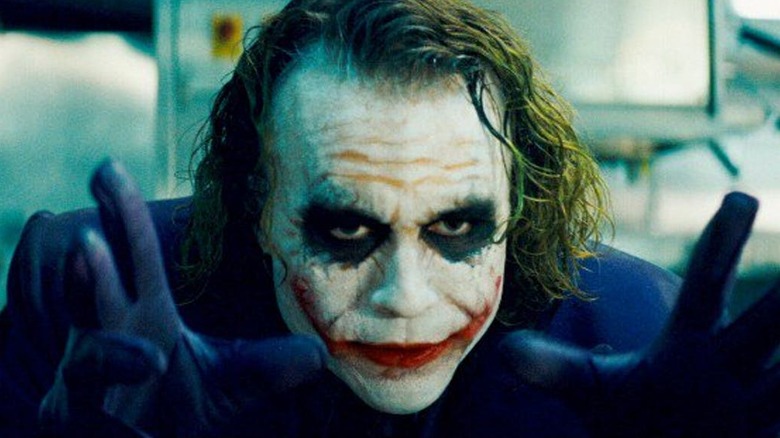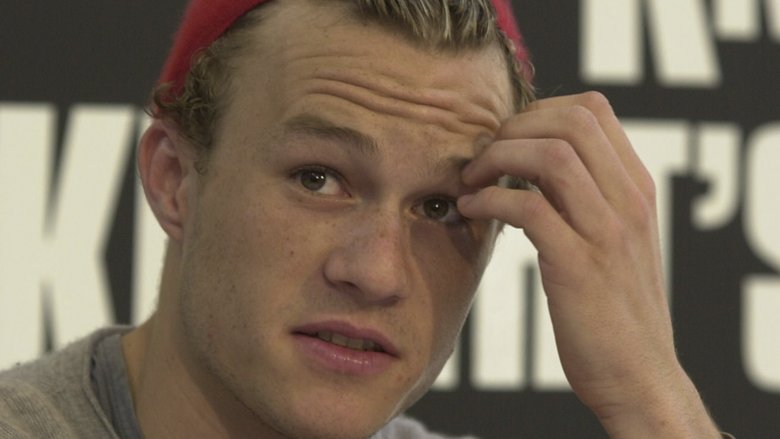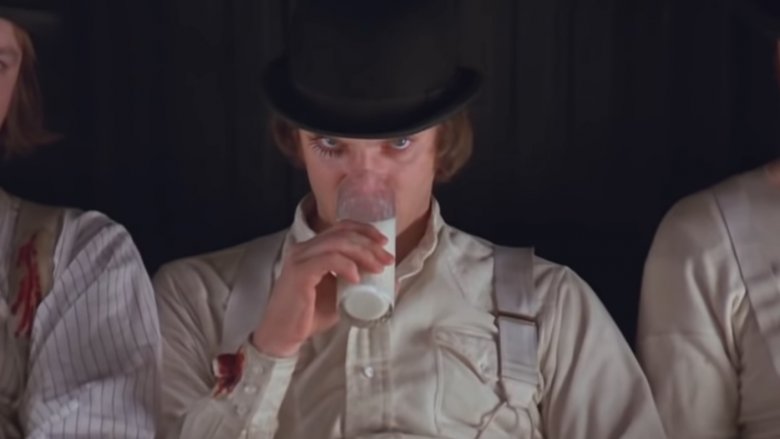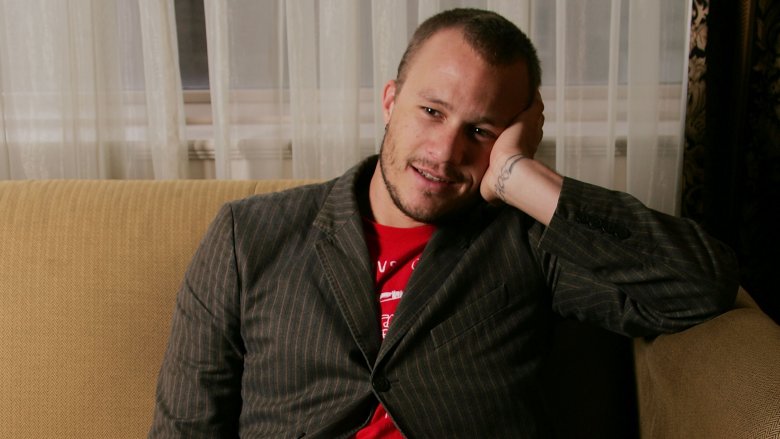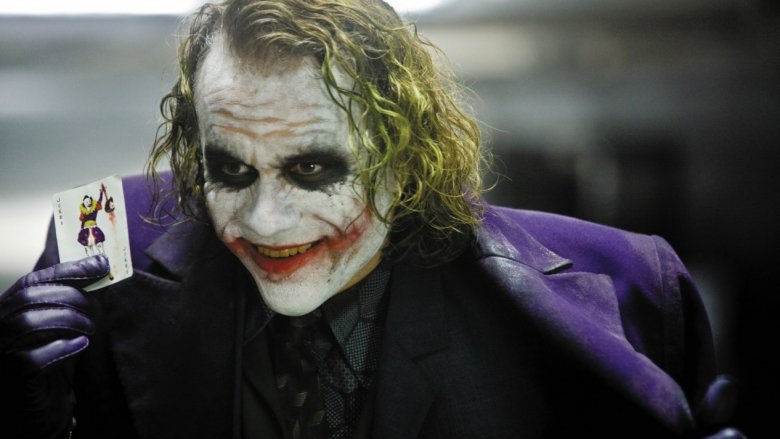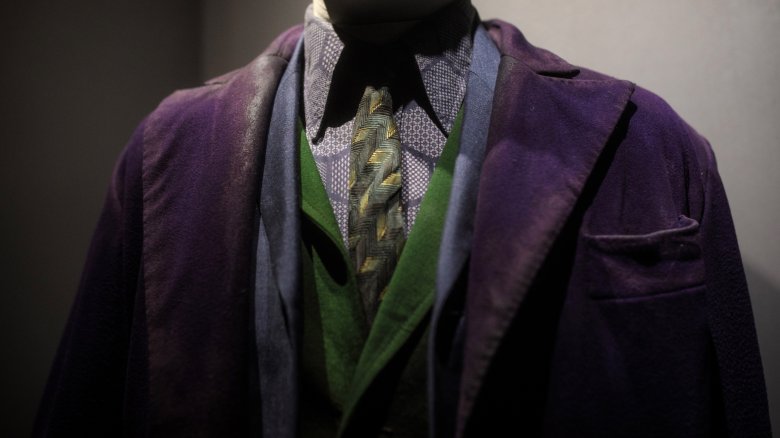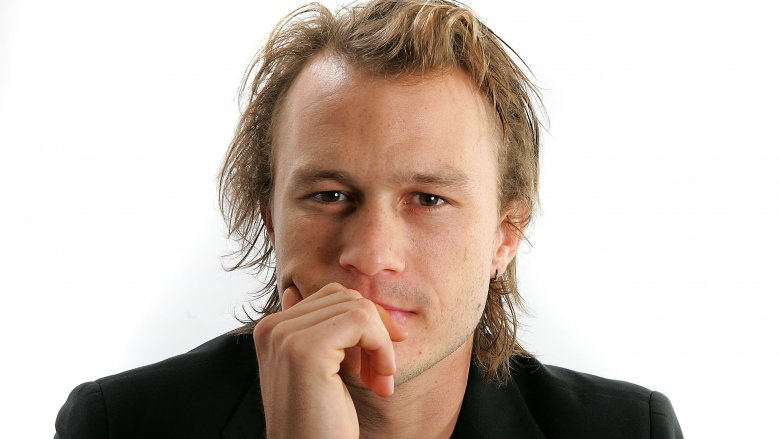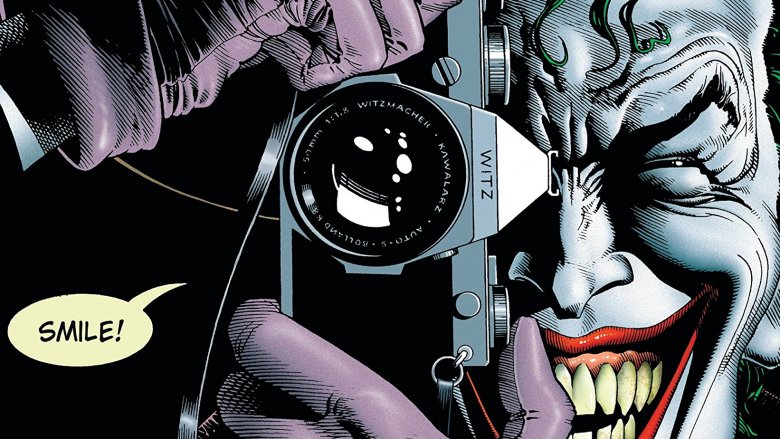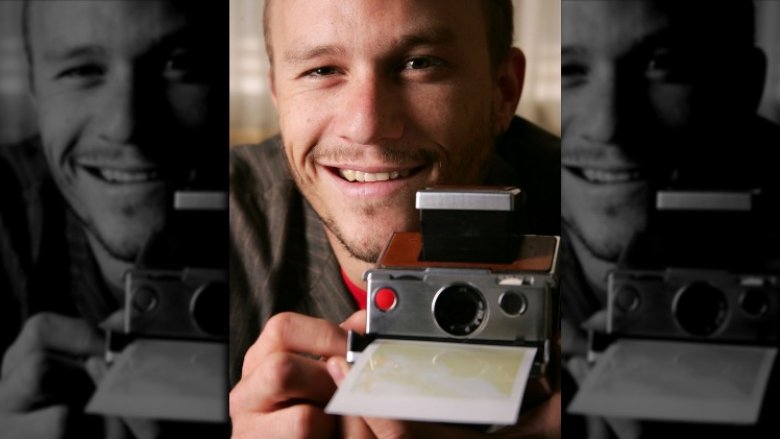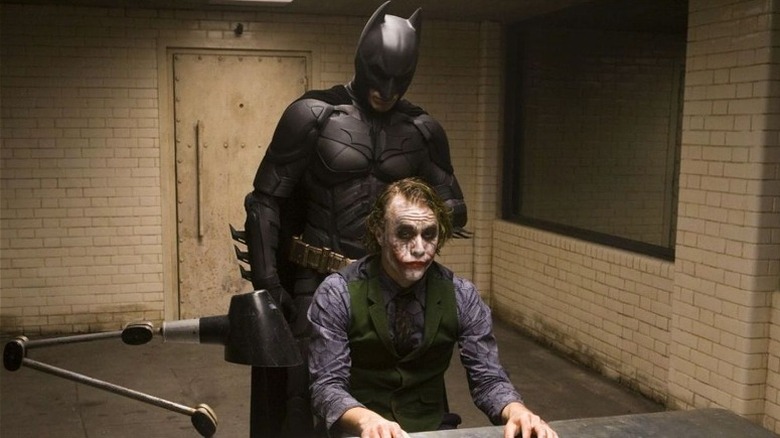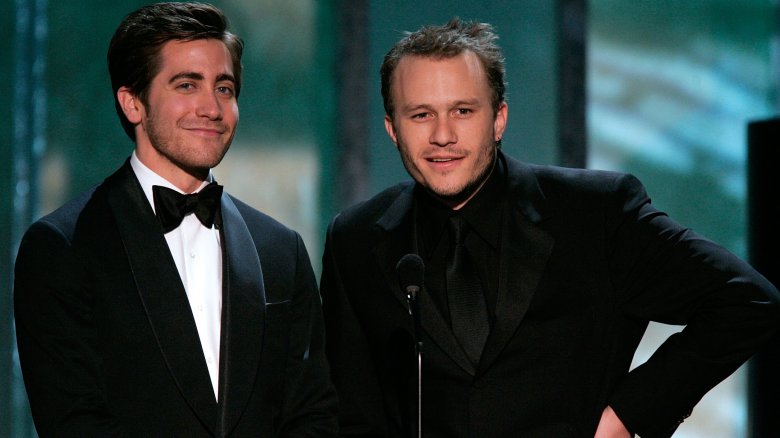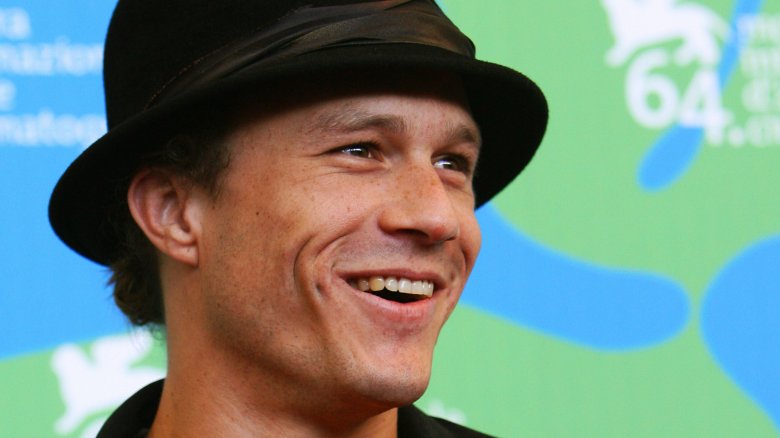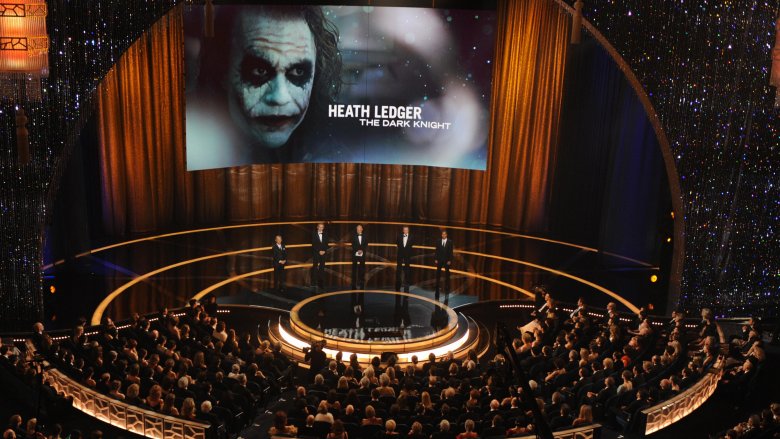How Playing The Joker Changed Heath Ledger For Good
Despite the initial uproar that erupted when Heath Ledger was announced as being cast in The Dark Knight, his turn as the Joker earned him accolades from critics and audiences alike. This was no small feat, as Ledger had some gigantic clown shoes to fill. Previously, the legendary comic book character had been portrayed onscreen by renowned actors such as Cesar Romero and Jack Nicholson, both of whom were still heavily associated with the character at the time.
In order to transform into his own unique version of the Joker, Ledger pushed himself physically and mentally further than he ever had for a role. From isolating himself for over a month to becoming heavily involved with makeup and wardrobe decisions for the character, Ledger put in every effort to set his performance apart from his predecessors. This extreme effort took a toll on the actor, leaving him exhausted and sleep deprived.
In the end, Ledger's issues with insomnia contributed to his premature death when the 28-year-old actor accidentally overdosed on prescription sleeping medication before the film's release. Ledger's untimely death sparked all kinds of rumors that transformed the actor's performance into the stuff of legends, but what's the truth about the many ways he threw himself fearlessly into one of the most iconic roles in modern cinema — and how it changed him for good?
Heath Ledger's insomnia skyrocketed when he prepared to play the Joker
Heath Ledger had a long history of sleep troubles, reportedly struggling with a racing mind for years before portraying the Joker. However, his chronic insomnia became much more prevalent and aggressive after filming The Dark Knight. His difficulty sleeping was summed up in a New York Times profile in 2007, while the film was in production: "It is a physically and mentally draining role — his Joker is a 'psychopathic, mass-murdering, schizophrenic clown with zero empathy,' he said cheerfully — and, as often happens when he throws himself into a part, he is not sleeping much."
During this interview, Ledger reported that he had slept an average of two hours per day over the previous week. He even mentioned taking one Ambien to no effect, and after taking another, he was only able to stay asleep for an hour. This interview, which took place several months before Ledger's death, shed light onto how sleep deprivation changed the young actor — and an offhand remark about his resistance to sleeping medications even eerily foreshadowed his imminent fatal overdose on prescription drugs.
Heath Ledger became a little more cultured studying to play the Joker
Although Christopher Nolan gave Heath Ledger quite a bit of creative control over his iteration of the Joker, he did suggest several sources of inspiration. These recommendations included the paintings of Francis Bacon, the Anthony Burgess novel A Clockwork Orange, and heavy metal music. Nolan suggested these so that Ledger could understand the type of Joker he was envisioning for the film, and several of these inspirations helped to form the final version that appeared onscreen.
One of the characters from A Clockwork Orange, Alex DeLarge, was particularly influential on Ledger's development of his Joker character. Several images of DeLarge appear throughout the legendary "Joker Diary" that the actor created during his self-imposed isolation in order to get into the right head space for the character. Since Alex DeLarge is depicted as a sociopath who steals and assaults innocent people purely for his own amusement in A Clockwork Orange, it is only natural that the Joker would consider him to be a kindred spirit. In fact, the Joker's iconic glare in The Dark Knight is considered to be a recreation of the famed "Kubrick Stare," the expression that DeLarge, played by Malcolm McDowell, utilized in the film version of A Clockwork Orange.
Heath Ledger isolated himself while playing the Joker
Since Heath Ledger wanted his rendition of the Joker to be completely different from any previous versions, such as those played by Jack Nicholson or Cesar Romero, he isolated himself in a London hotel for around six weeks in order to cultivate an entirely new character. It was during this time that Ledger studied the sources of inspiration with which Nolan had provided him. He also began writing and pasting pictures into the journal that would become the "Joker Diary" that he would bring on set to leaf through in order to get into character.
During a 2007 interview with Empire, Ledger briefly went over how his experience preparing for the role changed him: "I sat around in a hotel room in London for about a month, locked myself away, formed a little diary and experimented with voices." Although the isolation and creation of the Joker Diary were huge steps towards the formation of Ledger's Joker, his time experimenting with voices would turn out to be equally invaluable.
Heath Ledger improved his voice acting for the Joker
Seeing as some of the Joker's most iconic features are his mocking voice and sardonic laugh, Heath Ledger wanted to be sure his Joker's voice set him apart from those who had played the part before. This was no small feat, as greats such as Jack Nicholson had previously played the Joker onscreen and Mark Hamill had made his vocal mark on the character in animation.
In order to formulate his own unique voice for the Joker, Ledger practiced different pitches and tones during his hotel room isolation. He wanted to be sure that the voice he chose reflected the personality of the character he was envisioning, saying, "It was important to try to find a somewhat iconic voice and laugh. I ended up landing more in the realm of a psychopath — someone with very little to no conscience towards his acts." According to Nolan, Ledger had been studying ventriloquist dummies because he found their voices terrifying. He decided to try and emulate one and, using the training on inflections he had received from a voice coach, managed to "mouth" his dialogue to create an eerie sound effect.
Heath Ledger became involved in makeup and prop choices for the Joker
Although not all actors are deeply concerned with the costumes or props their character uses, The Dark Knight prosthetic supervisor Conor O'Sullivan said Heath Ledger became heavily involved with the painting of his face. Apparently, Ledger and makeup artist John Caglione gravitated toward a Francis Bacon painting that Nolan had recommended as inspiration for the Joker's makeup. Nolan went into more detail about how the makeup design helped flesh out Ledger's Joker character: "We have a Francis Bacon spin to [his face]. This corruption, this decay in the texture of the look itself. It's grubby. You can almost imagine what he smells like."
Besides working with Caglione on makeup design, Ledger was also very engaged in the wardrobe and prop departments. He worked closely with The Dark Knight costume designer Lindy Hemming when choosing the right chaotic outfit for the character. He even chose the Joker's signature weapon from a selection of different rubber knives laid out by the prop team.
Heath Ledger pushed himself to his limits for the Joker
In Heath Ledger: Too Young To Die, a German documentary on the actor's life, Ledger's father went into more detail on just how much his son changed to prepare for The Dark Knight: "He pretty well locked himself up in a hotel room for a month or so to galvanize the upcoming character in his own mind. That was typical of Heath on any movie. He would certainly immerse himself in the character and I think this was just a whole new level." Although Ledger was a seasoned method actor who had already sunk his teeth into challenging roles such as Ennis Del Mar in Brokeback Mountain, he pushed himself further than ever when getting into character for the Joker.
After Ledger's untimely death due to an accidental overdose of prescription sleeping medication, rumors ran rampant that his turn as the Joker had taken a toll on the young actor and led to his demise. However, a documentary titled I Am Heath Ledger, created by the actor's friends and family and released in 2017, dispels the theories about his death. During an interview with Entertainment Weekly following a screening of the documentary at the Tribeca Film Festival, the deceased actor's sister, Kate Ledger, officially set the record straight about his state of mind before his death: "He was having fun. He wasn't depressed about the Joker."
Heath Ledger let out his inner nerd for the Joker
Although Heath Ledger was incredibly successful in his portrayal of the Joker, he was initially very skeptical of superhero films. In fact, when Nolan began casting for The Dark Knight's predecessor, Batman Begins, he originally contacted Ledger about playing the titular character, but was turned down with the note that he would "never do this kind of film." Despite his lack of interest in comic book movies, Ledger quickly changed his tune after watching Batman Begins. He appreciated the realism that Nolan brought to the table so much that he enthusiastically reached out about playing the Joker in the sequel before the screenplay was even finished.
While he was preparing for the role, Ledger embraced his nerdy side and read several graphic novels that Nolan recommended, such as The Killing Joke. After his isolation, Ledger described his process of utilizing these comics to help him get into character: "It's a combination of reading all the comic books I could that were relevant to the script and then just closing my eyes and meditating on it."
Heath Ledger got to do some directing while playing the Joker
Heath Ledger also got his first chance to try some movie directing during his stint as the Joker. In The Dark Knight, the Joker makes two broadcasts threatening the people of Gotham City and taunting Batman. Although Nolan supervised the filming process, he granted Ledger complete creative control over these hostage videos, as he wanted to be sure they were taken from the Joker's perspective. Originally, Nolan was only planning on having the actor direct the first video, but he was so impressed by the result that he changed his mind, giving Ledger the opportunity to direct the second too.
Ledger had already expressed interest in trying his hand at directing, and this was his first real chance to branch out into a new artistic endeavor. Before his death, Ledger had already begun directing several music videos, such as Grace Woodroofe's David Bowie cover "Quicksand" and Modest Mouse's "King Rat." He was also in the process of adapting the 1983 novel The Queen's Gambit into a feature-length film, but his untimely death sadly stopped him from finishing the project.
Heath Ledger tested his physical limits for the Joker, too
Heath Ledger didn't just push himself mentally to get into character for the Joker — he also pushed himself physically. The actor was so dedicated to the role that he actually encouraged Christian Bale to physically assault him in order to make one scene more authentic. Although Bale tried to convince Ledger that the scene would look just as real if they faked the fighting, Ledger insisted that Bale didn't pull any punches, and even tried to provoke him to hit harder.
Bale himself went into more detail about working on this scene with Ledger during an interview with The Hollywood Reporter: "He was kinda egging me on. I was saying, 'You know what, I really don't need to actually hit you. It's going to look just as good if I don't.' And he's going, 'Go on. Go on. Go on...' He was slamming himself around, and there were tiled walls inside of that set which were cracked and dented from him hurling himself into them. His commitment was total." Despite Bale's attempts to convince his co-star that faking the fight would still look just as realistic, Ledger was determined to have it be as authentic as possible. Few actors are so committed to their roles that they would happily crack tiles by throwing themselves into walls.
Heath Ledger became an improv master thanks to the Joker
Although the Joker character was developed by the screenwriting/directing team of Christopher and Jonathan Nolan, Heath Ledger alone gave birth to some of the most iconic Joker moments through improvisation. One of the most notable examples of Ledger's contributions came during his scene in Gotham lockup, when he mockingly applauds after Gordon gets promoted. Even though the clapping was not originally written in The Dark Knight's script, Nolan loved Ledger's sarcastic clap so much that he ended up including it. There were also rumors that Ledger changed the hospital destruction scene, improvising moments when Joker looks confused and fiddles with the detonator before the explosion follows a few moments later. However, the story has had some holes poked through it, suggesting that the scene may have been scripted.
This sudden talent for improvisation was a surprise coming from Ledger, as he had never been known to improvise scenes before. In fact, director Ang Lee recounted Ledger becoming upset when his Brokeback Mountain costar Jake Gyllenhaal tried going off script. "Heath just got really upset — really upset, like his whole progress was disrupted," Lee recalled. "Jake is more of an improv actor — try this, try that — but Heath's preparation was really deep.'"
Heath Ledger fell in love with the character while playing the Joker
Despite the fact that Heath Ledger had never read a Batman comic book before he began preparing for his role, he quickly fell in love with the character of the Joker. He considered the Joker to be an instant favorite in his career, and co-star Christian Bale recalled Ledger telling him that it was the most fun he'd ever had with a character. Bale himself went on to corroborate how much Ledger enjoyed shooting The Dark Knight after rumors of depression surrounded the young actor's death, telling reporters, "I saw him as having nothing but the best time playing the Joker... at the end of the day, he was having a wonderful time making this movie. I say he couldn't have been happier doing it."
Ledger's own sister Kate stepped into the spotlight to dismiss rumors that his overdose was intentional, and even revealed that Ledger had already been planning to return as Joker. "He was so proud of what he had done in [The Dark Knight]," she said, "and I know he had plans for another Batman. He loved working with Chris Nolan and Christian Bale and Gary Oldman. He just had the best time ever doing that film." Clearly, Ledger felt a strong fondness for his Joker persona, considering he was already planning a role in Nolan's follow-up before The Dark Knight was even released.
The Joker cemented Heath Ledger's legacy
Heath Ledger broke down quite a few boundaries with his Joker performance in The Dark Knight when awards season rolled around. Most superhero films, despite constantly topping box office sales, are rarely considered by the Academy. However, Ledger's turn as the Joker brought quite a bit of attention to this previously overlooked genre, and earned him a multitude of honors. These included a Golden Globe, British BAFTA, Screen Actors Guild award, and many more U.S. and Australian critics awards.
Making great strides for superhero films wasn't the only way Ledger's posthumous awards changed his legacy. He joined a very select company after winning, becoming one of only two actors to win an Oscar after death. Before him, Peter Finch had won for his work in the 1976 satirical film Network after passing from a heart attack. Ledger had been nominated for Best Actor for his role in Brokeback Mountain back in 2006, but never got to see a win. His father, Kim, accepted the award for Dark Knight on his behalf with a beautiful statement on Heath's legacy: "This award tonight would have humbly validated Heath's quiet determination to be truly accepted accepted by you all here, his peers, in an industry that he so loved."
